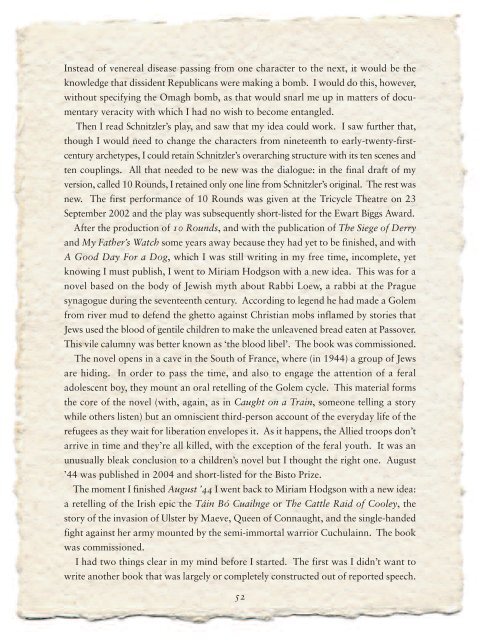The Cathach 2011 - Volume II (PDF) - Sligo Libraries
The Cathach 2011 - Volume II (PDF) - Sligo Libraries
The Cathach 2011 - Volume II (PDF) - Sligo Libraries
Create successful ePaper yourself
Turn your PDF publications into a flip-book with our unique Google optimized e-Paper software.
Instead of venereal disease passing from one character to the next, it would be the<br />
knowledge that dissident Republicans were making a bomb. I would do this, however,<br />
without specifying the Omagh bomb, as that would snarl me up in matters of documentary<br />
veracity with which I had no wish to become entangled.<br />
<strong>The</strong>n I read Schnitzler’s play, and saw that my idea could work. I saw further that,<br />
though I would need to change the characters from nineteenth to early-twenty-firstcentury<br />
archetypes, I could retain Schnitzler’s overarching structure with its ten scenes and<br />
ten couplings. All that needed to be new was the dialogue: in the final draft of my<br />
version, called 10 Rounds, I retained only one line from Schnitzler’s original. <strong>The</strong> rest was<br />
new. <strong>The</strong> first performance of 10 Rounds was given at the Tricycle <strong>The</strong>atre on 23<br />
September 2002 and the play was subsequently short-listed for the Ewart Biggs Award.<br />
After the production of 10 Rounds, and with the publication of <strong>The</strong> Siege of Derry<br />
and My Father’s Watch some years away because they had yet to be finished, and with<br />
A Good Day For a Dog, which I was still writing in my free time, incomplete, yet<br />
knowing I must publish, I went to Miriam Hodgson with a new idea. This was for a<br />
novel based on the body of Jewish myth about Rabbi Loew, a rabbi at the Prague<br />
synagogue during the seventeenth century. According to legend he had made a Golem<br />
from river mud to defend the ghetto against Christian mobs inflamed by stories that<br />
Jews used the blood of gentile children to make the unleavened bread eaten at Passover.<br />
This vile calumny was better known as ‘the blood libel’. <strong>The</strong> book was commissioned.<br />
<strong>The</strong> novel opens in a cave in the South of France, where (in 1944) a group of Jews<br />
are hiding. In order to pass the time, and also to engage the attention of a feral<br />
adolescent boy, they mount an oral retelling of the Golem cycle. This material forms<br />
the core of the novel (with, again, as in Caught on a Train, someone telling a story<br />
while others listen) but an omniscient third-person account of the everyday life of the<br />
refugees as they wait for liberation envelopes it. As it happens, the Allied troops don’t<br />
arrive in time and they’re all killed, with the exception of the feral youth. It was an<br />
unusually bleak conclusion to a children’s novel but I thought the right one. August<br />
’44 was published in 2004 and short-listed for the Bisto Prize.<br />
<strong>The</strong> moment I finished August ’44 I went back to Miriam Hodgson with a new idea:<br />
a retelling of the Irish epic the Táin Bó Cuailnge or <strong>The</strong> Cattle Raid of Cooley, the<br />
story of the invasion of Ulster by Maeve, Queen of Connaught, and the single-handed<br />
fight against her army mounted by the semi-immortal warrior Cuchulainn. <strong>The</strong> book<br />
was commissioned.<br />
I had two things clear in my mind before I started. <strong>The</strong> first was I didn’t want to<br />
write another book that was largely or completely constructed out of reported speech.<br />
52


